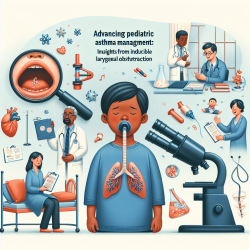Introduction
In the ever-evolving field of genetics, the study of DNA methylation has emerged as a powerful tool in diagnosing rare syndromes, offering new hope for practitioners and families alike. A recent study titled "Genetically unresolved case of Rauch-Steindl syndrome diagnosed by its wolf-hirschhorn associated DNA methylation episignature" highlights the clinical utility of DNA methylation episignature analysis in resolving complex genetic cases. This blog explores how practitioners can leverage these findings to enhance their diagnostic capabilities and encourages further research into this promising area.
The Case Study: A Breakthrough in Diagnosis
The research presented a case of a young boy with developmental delay, dysmorphic features, and short stature. Initial genetic testing, including chromosomal microarray and whole exome sequencing, failed to provide a diagnosis. However, the application of DNA methylation episignature analysis revealed a positive match for the Wolf-Hirschhorn syndrome (WHS) episignature, leading to the identification of a previously undetected frameshift variant in the NSD2 gene, resulting in a diagnosis of Rauch-Steindl syndrome (RAUST).
Implications for Practitioners
For practitioners, this study underscores the importance of incorporating DNA methylation analysis into the diagnostic process for unresolved cases. Here are some actionable steps practitioners can take:
- Expand Diagnostic Tools: Consider integrating DNA methylation episignature analysis into routine testing for patients with ambiguous genetic findings.
- Stay Informed: Keep abreast of the latest developments in epigenetics and molecular diagnostics through conferences, publications, and webinars.
- Collaborate: Engage with geneticists and researchers to explore multi-omics approaches that combine genomic, epigenomic, and transcriptomic data for comprehensive diagnostics.
Encouraging Further Research
The study opens avenues for further research into the role of DNA methylation in neurodevelopmental disorders. Researchers are encouraged to:
- Explore New Episignatures: Investigate the potential for discovering new episignatures associated with other rare syndromes.
- Phenotypic Correlations: Conduct studies to correlate phenotypic features with specific methylation patterns to refine diagnostic criteria.
- Functional Studies: Examine the impact of methylation changes on gene expression and developmental pathways.
Conclusion
The integration of DNA methylation episignature analysis into the diagnostic toolkit represents a significant advancement in the field of genetics. By adopting these innovative approaches, practitioners can improve diagnostic accuracy, provide timely interventions, and ultimately enhance the quality of life for patients with rare genetic disorders. As we continue to unravel the complexities of the human genome, the potential for breakthroughs in diagnosis and treatment is immense.
To read the original research paper, please follow this link: Genetically unresolved case of Rauch-Steindl syndrome diagnosed by its wolf-hirschhorn associated DNA methylation episignature.










